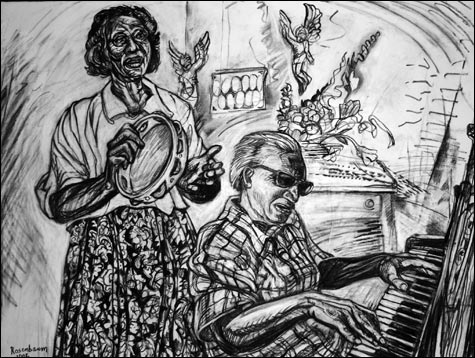
LIVING-ROOM FOLK: When he wasn’t recording Sister Fleeta Mitchell and Willie Mae Eberhard, Art Rosenbaum was drawing them. |
With the release in late 2003 of the six-disc Goodbye, Babylon box set of gospel music from the era of 78s, the Dust-to-Digital label set the standard for reissue collections of American folk and roots music. Sumptuously packaged and meticulously researched, it was a testament not only to the power and beauty of the religious music and oratory of the South but also to the dedication and devotion of a small group of collectors and preservationists like Joe Bussard, Dick Spottswood, and Dust-to-Digital founder Lance Ledbetter. The obsessions of such collectors have formed the foundation for a number of subsequent releases, from the deluxe anthology of singles from Bussard’s 78 rpm label Fonotone to Ian Nagoski’s early ethnic-folk-music collection The Black Mirror.
In recent months, Dust-to-Digital has released a batch of excellent sets, everything from Tuvan throat singing to an uncanny two-disc selection of exotic shellac favorites curated by members of the Seattle experimental group Climax Golden Twins. But the cream of the label’s current crop is Art of Field Recording, Volume I, the first installment in a planned three-volume collection of traditional American music recorded by Art Rosenbaum.
As a young art student at Columbia in the mid ’50s, Rosenbaum was in thrall to early American folk music. His entrée into field recording came when he heeded Pete Seeger’s advice: “Don’t learn from me, learn from the folks I learned from.” Rosenbaum was soon out in the field, recording artists as they played music on their front porches and in their living rooms, their back yards, their churches. He traveled around the country on these expeditions, journeys reflected in the breadth of Art of Field Recording. There are plenty of examples of the rich folk traditions of the South (particularly Georgia, where Rosenbaum lives), but there’s also Irish music from New York, Mexican songs from the Great Lakes region, fiddle tunes from Indiana, and French Canadian folk from New Hampshire.
The four-disc collection offers countless revelations. There’s the intense, ebullient singing of septuagenarian Sister Fleeta Mitchell, who delivers three spirited Pentecostal hymns. And there’s the beautifully weathered singing of Mary Lomax, whom Rosenbaum describes in the liner notes as “perhaps the finest previously unrecorded old-time traditional Appalachian singer to emerge in the 21st century.”
In a nod to Harry Smith’s canonical Anthology of American Folk Music, Rosenbaum groups the music into four categories: Survey, Religious, Blues, and Instrumental & Dance. Although the names of banjo player Buell Kazee and bluesman Scrapper Blackwell should be familiar to fans of old-time roots music, most of the artists are appearing on CD for the first time, and indeed the greatest pleasures come from these lesser-known figures, like North Carolina singer Bobby McMillon, or flutist Newt Tolman (a/k/a Newt the Flute), from the very small town of Nelson, New Hampshire, a person I recognized as a fixture from the local contra dances of my early childhood.